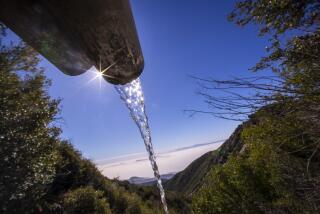Who is taking Californiaâs water?
As Californiaâs drought really starts to bite--the mandatory water use restrictions approved by the state Tuesday are just the beginning--questions are bound to be raised about the indescribably wasteful use of water to retail bottlers.
The sale of bottled water to most Americans, who have access to cheap and safe tap water from municipal systems, is a marketing scam, and environmentally devastating besides. As Peter H. Gleick of the Oakland-based Pacific Institute showed in 2007, it took the equivalent of 17 million barrels of oil to produce the plastic bottles for American buyers in 2006. That would be enough to fuel 1 million American cars and light trucks for a year.
âBottled water requires energy throughout its life cycle,â Gleick has written. âEnergy is required to capture, treat, and send water to the bottling plant; fill, package, transport, and cool the bottled water; and recycle or dispose of the empty containers.â
Consider the unnecessary energy usage in shipping, say, Fiji Water to these shores from a Pacific island dictatorship 5,000 miles away, all to satisfy the marketing thirst of the productâs distributors, Lynda and Stewart Resnick of Beverly Hills. And while youâre cradling that shiny square bottle in your hands, keep in mind that 30% of Fijiâs 800,000 residents donât have access to clean drinking water themselves.
The drought is bound to focus more attention on the extraction of water from California sources for retail sale. The Desert Sun of Palm Springs started that process this week, with an exhaustive look at the deal between the Morongo Band of Mission Indians and Nestle Waters North America, which draws water for its Arrowhead brand from sources on the reservation.
The piece was not as exhaustive as it could have been, because neither Nestle nor the Morongo are forthcoming about how much water is being drawn. The local water district says the tribe hasnât updated its report of groundwater extractions since 2009.
Thatâs not surprising: state officials have been trying to revoke the Morongosâ rights to that water for more than 10 years, based on the argument that the rights lapsed once the water ceased to be used for irrigation.You can expect the issue to intensify, as residential growth continues in the area and available water supplies diminish.
Nestleâs drawing of water from the desert aquifer is a special concern, Gleick told the Desert Sun, âprecisely because water is so scarce in the basin.... Surface water in the desert is exceedingly rare and has a much higher environmental value than the same amount of water somewhere else.â
The tribeâs response to questions thus far has been to cite its sovereign status. But times and conditions are changing. If the drought continues or gets worse, the retail shipment of water out of the region or state will become seen as an unsustainable anachronism. All water users--growers, factory owners, urban residents--are being forced to change their ways. Water bottlers canât avoid the same reality.
Keep up to date with The Economy Hub by following @hiltzikm.
More to Read
Inside the business of entertainment
The Wide Shot brings you news, analysis and insights on everything from streaming wars to production â and what it all means for the future.
You may occasionally receive promotional content from the Los Angeles Times.











